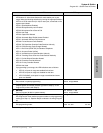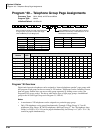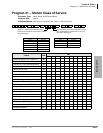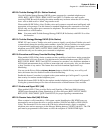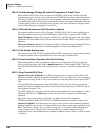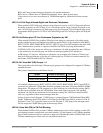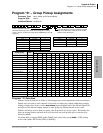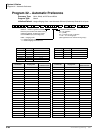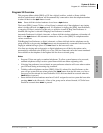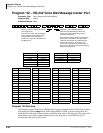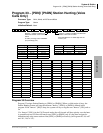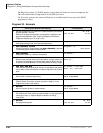
System & Station
Program 31 – Station Class of Service
Strata DK Programming 5/00 3-87
System & Station
BOV and Camp-on muted ring tone frequency for standard telephone:
BOV tone is a 160ms burst of 1209Hz/ unmodulated, twice - three seconds apart.
Camp-on tone is two one-second bursts of 1209Hz/interrupted by 160ms bursts, three seconds
apart.
LED 10: All Call Page Allowed-Digital and Electronic Telephones
When enabled, (LED 10 On) any station can be allowed to receive an All Call Page and still have
the ability to initiate an All Call Page. Up to 120 stations can be can be assigned and paged at one
time. All Call Page is treated as any other page group. See Program 30 for telephone page group
assignments and Program 10-2, LED 15 for External Page with All Call Page option (see Program
34).
LED 09: No Station plus CO Line Conference Origination by VM
When enabled (LED 09 On), prohibits VM ports from setting up conference calls with a station
and the outside line party and tandem calls with two outside lines. Use this feature for VM (RSTU,
RSTU2, PSTU, PESU, RDSU/RSTS, KSTU2, QSTU2) ports. This LED should be On when VM/
Auto Attendant does screened or supervised transfers and Off if only doing blind transfers.
If LED 09 is Off or On, station can still set up a conference call with an outside line and a VM port
so the station user and outside party can listen to a message together (R3.2 and above).
In DK release 3.2 software, VM ports are allowed to set up tandem calls with two CO lines and
then hook-flash and hang-up to exit the call, allowing the two CO lines to remain connected. For
this feature, LED 09 must be Off for VM ports.
LED 05~08: Voice Mail (VM) Groups 1~4
The system allows the following VM station port groups to be configured for support of VM/auto
attendant devices:
One group is intended for each different device.
All standard telephone ports (RSTU, RSTU2, PSTU, PESU, RDSU/RSTS, KSTU2 and QSTU2)
connected to a particular VM machine should be assigned to the same VM group (SMDI or DTMF
Integration). The purpose of VM grouping is to allow efficient use of the message waiting (MW)
set and cancel operations from the VM machine. Since each digital, electronic, and standard
telephone can only have a maximum of four messages waiting, the VM device should set MW
only once, regardless of how many messages there are.
Assign all ports of each Program 31 VM Group to a unique Program 40 Distributed Hunt (DH)
Group. Telephones should Call and/or Call Forward to the DH Group [DN] to connect to VM. In
Programs 13 and 32, assign the lowest port in the Program 31 VM group as the message center.
Do not assign the VM DH Group port as the message center.
LED 04: Voice Mail (VM) to VM Call Blocking
When enabled (LED 04 On), prevents VM/auto attendant ports from call forwarding to other VM
ports during screened or supervised voice mail transfers. Use this feature for all VM/auto attendant
ports if their transferred calls are screened or supervised. Disable this feature (LED 04 Off) for all
VM/auto attendant ports if their calls are ring (blind) transferred.
System Number of VM Groups LEDs
DK14 1~2 05~06
DK40i, DK424, DK424i 1~4 05~08





